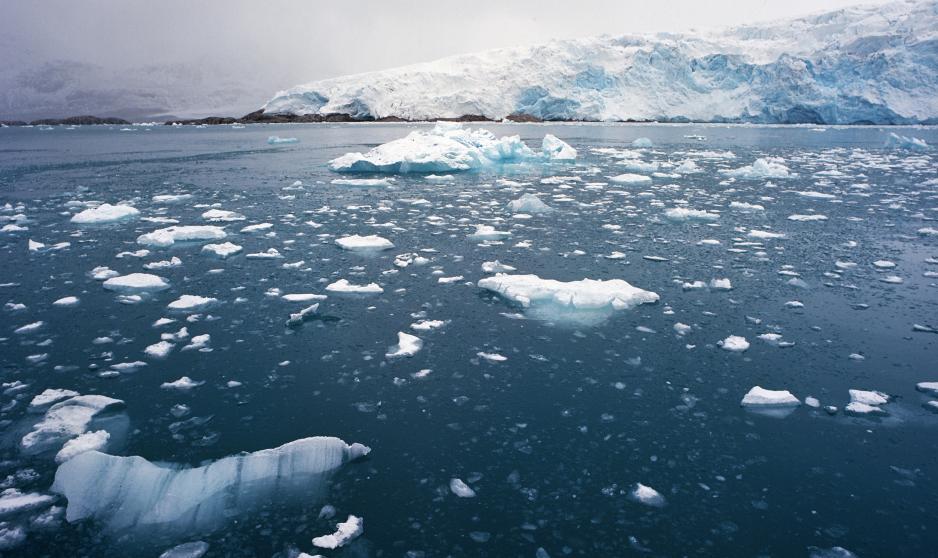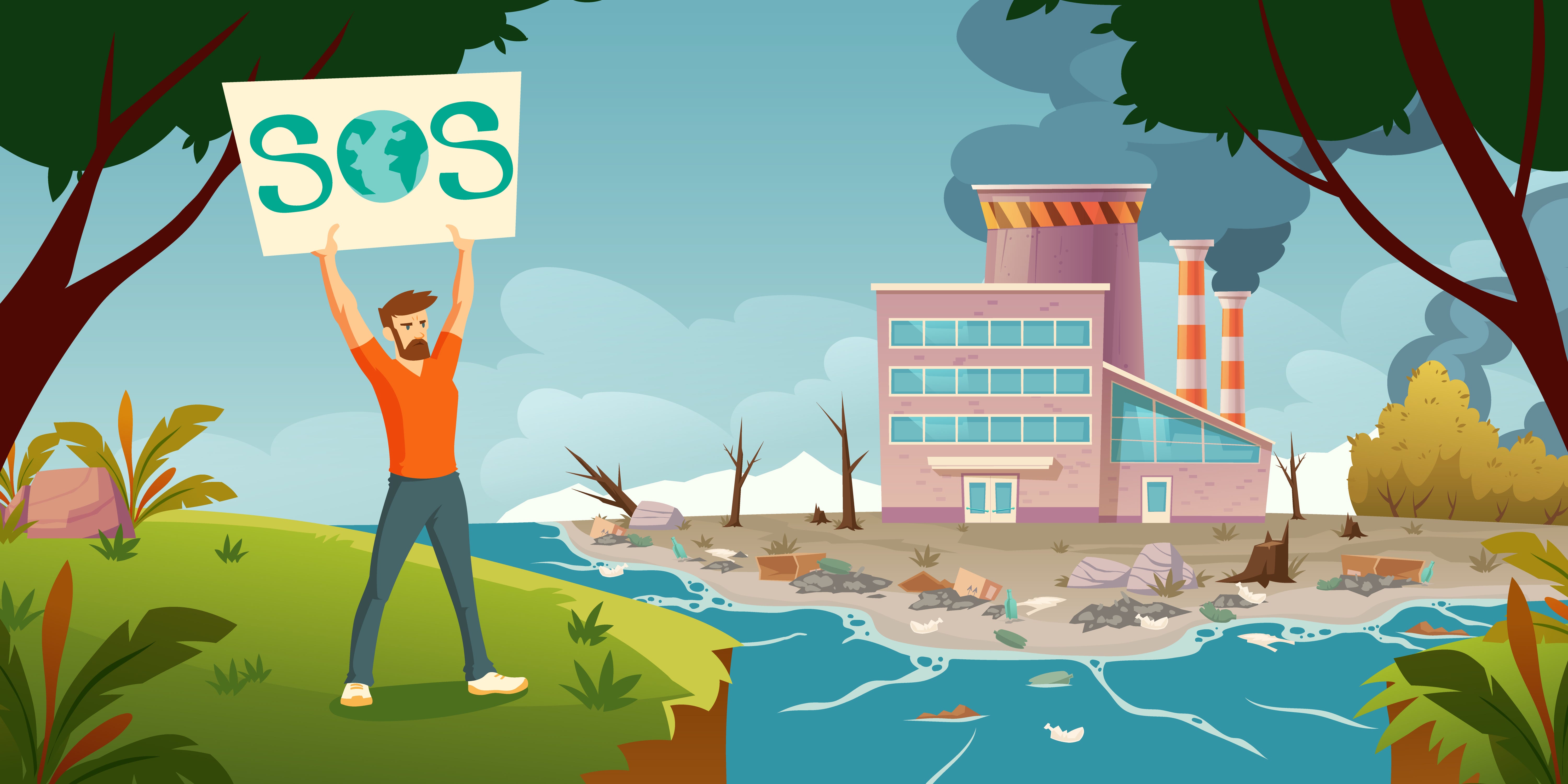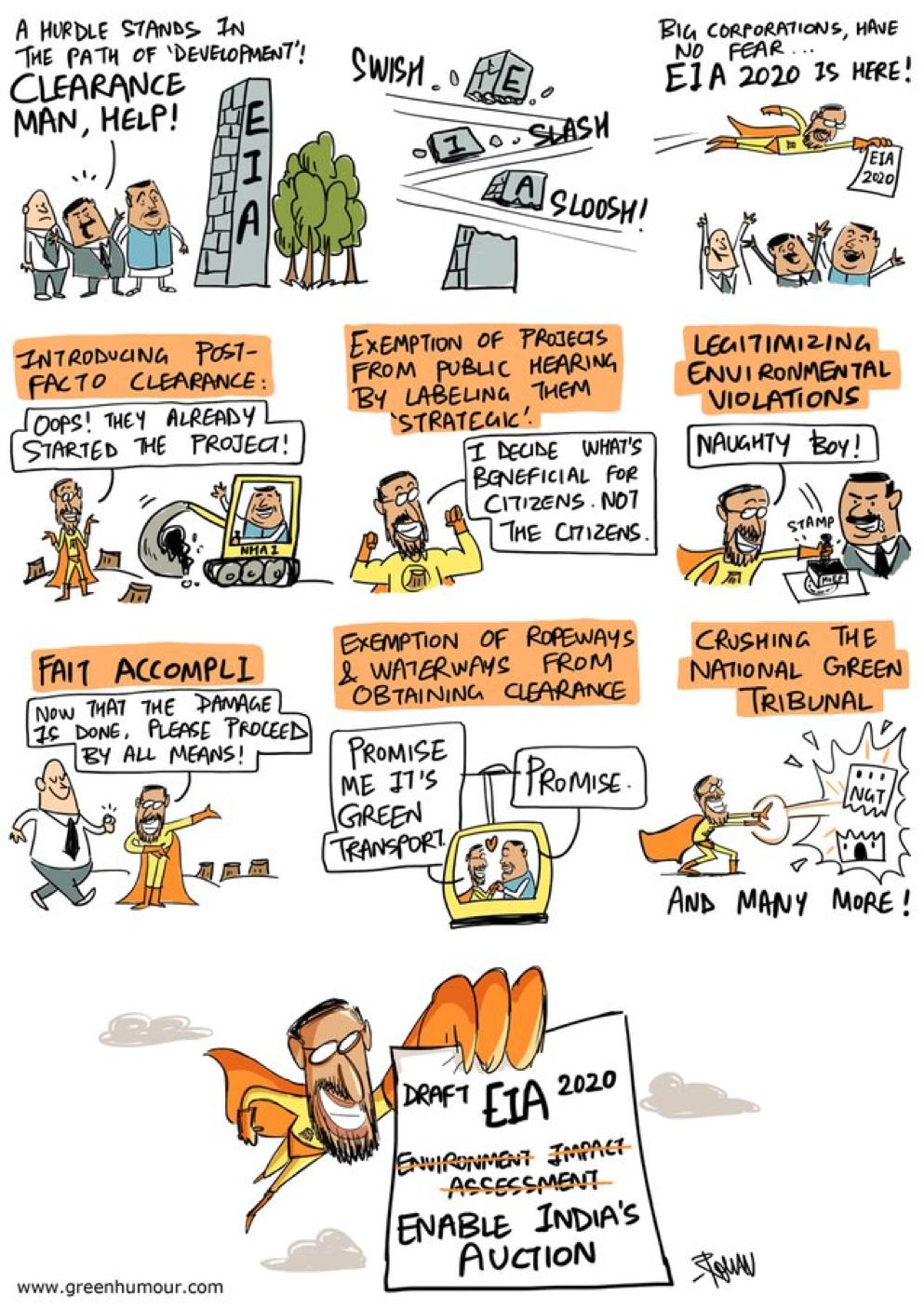If you’re reading this, you are most probably a student under 25 years of age, most probably studying in Jamia Millia Islamia or some other leading university of the country. At the risk of sounding like an alarmist, this also means that if you’re reading this, it is inevitable that you are going to witness the radical destabilization of life brought about by the effects of climate change in your lifetimes, something what the scientists call have been calling the ‘climate collapse’.
When faced with the situation of ‘climate change‘ or ‘climate collapse’, you can choose to be part of various schools of thought: either you can imagine that the climate collapse is preventable, and try your best to at least delay it, or you could choose to believe in the inevitability of the destruction of our species, and start working with that, for any action taken in the absence of consequences becomes an exercise in hope, or, you could choose to be aggressively stupid and ignorant about all of this and decide to go down in a blaze of glory while the Amazon burns, the Arctic goes through its first heatwave and the island nation of Tuvalu faces the threat of extinction.


Which brings me to the Draft EIA (Environmental Impact Assessment) Notification of 2020. If you don’t know, the EIA Notification is a document that is used as a framework to evaluate the environmental impact of any given project in the country that accesses, utilizes, and/or pollutes natural resources. It was introduced in 1994 under the Environment Protection Act of 1986, which in turn was formed as a reaction to the gas leak at the Union Carbide Factory in Bhopal in 1984, which was the first major event to draw attention to the environmental consequences of industries in India.

It is a well-documented fact that the amendment to the EIA Notification, 2020 has been drafted in way that would ensure ‘ease of business’ in a post-lockdown world and fast-track the economy back on track. The main point of the whole amendment is to make up for the losses that the economy incurred during the COVID-19 Pandemic, which can be very conventionally interpreted as a part of the ‘environment versus economy’ debate and the government prioritizing the latter over the former. The basis of this dichotomy rests in a worldview which bears the imprint of the thought processes of the generation before ours, formalized by the Rio Summit and the Kyoto Protocol, where the economy and the environment were things to be balanced. But, those ideas are outdated now: the major reason behind it being that we as species have outgrown these ideas, the subtext being that any ideas of morality or ethics or legality that we codified when our civilization was in its formative stages: for example, the idea of murder being accepted universally as illegal or unethical probably springs from the fact that we had achieved a stage in our evolution where killing another member of the same species would hurt the general equilibrium of the larger human group and similarly, a school of scholars believed that the institution of patriarchy was instituted and formalized because at some point in the evolution of our species, it was necessary that women primarily take the roles of mothers and nurturers.

Darwin theorizes that the goal of humans as species is not to attain salvation in the after-life or attain heaven for eternity, it is to survive, something which Freud describes as life force. Therefore, every decision we make as a species, despite the fact that the human civilization is an attempt by our species to escape its nature, still revolves around the very natural instinct to survive. The society that was created during the industrial revolution was not faced with the urgent question of survival, nor did subsequent generations until today. To you and I, climate change is not merely a threat lingering in the background, it is an existential threat. Therefore, to us, the economy is not a viable competitor to the survival of our species. This is a problem that is the most pronounced in our generation and will amplify with forthcoming ones. Make no mistake, no other issue will exist if we don’t have the Earth.
Another byproduct of the way of thinking that originated with the Industrial Revolution is what has been perhaps an attempt by humanity to escape its own inherent nature and build something which stand in gross opposition. Since the second half of the 2010s, starting with America, there has been a rise in governments that would consider money a more essential commodity than natural resources, and these governments aren’t in third-world nations you’ve never heard of, but in countries like first world countries like USA, UK and Brazil. It’s not just Duterte or Berdimuhamedov anymore, it’s Trump, Boris and Bolsonaro.

I would like to argue here that the apparent motives of the Draft EIA Notifications of 2020 are a representation of that very idea that still considers the economy to be something that comes with the environment as what a basic economics textbook would tell you is the ‘opportunity cost’, where development comes with destruction, which is absolute hogwash. The generations before ours could afford to maintain some sort of balance between the two, but when the survival of a species is threatened, extreme steps become inevitable. Following this line of thought, I would consider the Draft EIA Notifications of 2020 a step that goes towards endangering the very existence of our species in the name of a quick buck. Let me tell you how specifically. For the purpose of convenience, I will put them in a numbered list.
- The Draft EIA Notification, 2020 seeks to alter the process of public participation, which was instituted by the Rio Declaration. The process of public participation is necessary to obtain environmental clearance for any project – Presiding Officer’s Consent, Newspaper Publication, Public Response, and Sending Proceedings to the Regulatory Authority. According to the 2006 Rules, the Member Secretary’s Finalization took 7 days, there was no deadline for Newspaper Publication, 30 days were given for public response, and within 8 days, Proceedings were to be sent to Regulatory Authority. This process ensured that the local communities that were being impacted by a certain project had a say in its approval, because they are the ones facing long term consequences in the immediate vicinity. This has become more important in the light of sensitive projects such as the Hydroelectric Plant in the Dibang Valley, a Railway Line being built in the middle of the Western Ghats, which are home to communities who don’t have much access to mainstream education and thus tend to not understand what the consequences of a certain project can be, or they have such minimal say that they can’t impact the power large organizations have over the whole process, as has been shown by the Godda Village controversy which includes Adani Power. The 2020 rules seek to alter the amount of days that the processes of public clearance take. So, ten days are given for the Presiding Officer’s Approval, 5 days for Newspaper Publications, 20 days for Public Response and 10 Days for Regulatory Authority’s approval. Therefore, equal focus is given to Authorities and the People themselves. This takes away time from the local communities to voice their own grievances.
- If a constructed structure is expanded without Environmental Clearance, then it merely becomes a violation, which can be fixed by certain set processes: the project component has to assess the ecological damage as per Central Pollution Control Board guidelines. According to this assessment, the Regulatory Authority then decides remedial measures, and a penalty is levied on the violator on a per day basis However, any sense of illegality is removed from these extensions, and the people who are violating environmental norms can get away without any sort of punishment for their deeds. Therefore, any such activity is not illegal anymore and thus the perpetrators can be let go with something as small as a fine. This provision comes from Indian Council for Enviro-Legal Action vs. Union of India, which established the polluter pays principle, where anyone carrying out such activities must compensate the individuals who are getting impacted by it. But, as established by the NGT in the Sonal Ailawadi vs. Volkswagen India Pvt. Ltd. Case, the polluter pays principle didn’t mean that someone can pollute and then get their way by paying for it. However, if we were to understand the precedent that has been established the regularization of illegal constructions in cities like Delhi, it means the polluter can pay and get away with it, which were done because illegal constructions were too huge in numbers to be deemed illegal. Therefore, it won’t be a notion far from reality that this rule stands in direct violation of the NGT ruling. This is done by the granting of Post-Facto Clearances, which means projects currently violating the norms can apply for clearances.
- Under Clause 26 of the EIA Rules, 40 kinds of industries have been exempted from Prior Environmental Clearance, including those deemed ‘strategic’ by the government. The details of these projects do not have to be presented before the public or get clearance from them either. The clever play here is that any area that is under 100 kms of the Line of Actual Control falls under this rule too, therefore covering much of the Northeast. Highways, Inland Waterways, and small construction projects, under 1.5 lakh square kilometers are exempt too.
- Now, because the acts of unauthorized constructions themselves have been stripped of their illegal aspects, it naturally follows that it would be harder for anyone to seek grievances against them. Really pay attention now, because this is where the damage becomes more apparent than other subtle changes. Under Sub-Clause 1 of Clause 22 of these rules, ‘any person’ cannot report unauthorized constructions or projects, the right is simply transferred to Suo Moto applications or governmental authorities. Therefore, any common person – it doesn’t even matter if they are directly impacted by the environmental impact of a certain construction or not – cannot seek recourse against these actions without going through a proper governmental channel or unless the people who are perpetrating the very act themselves openly admit that they are the ones breaking the law. This ensures that environmental activists and even the very people whose lives are potentially at risk by the completion of a certain erstwhile illegal project stay away from the legal side of things.
The question that thus follows for the conservationist is: what do I do now? The answer to this question comes from the observation of a certain pattern: capitalism, in the neo-liberal form that it exists in today, has conditioned us to fight climate change as individuals and not as communities: look no further than any advertisement regarding climate change that is issued in the mainstream. Now, any such ad would teach you to take individual action: conserve electricity at home, use the stairs instead of the elevator, save paper, buy local, cut down on meats, switch off that damn air-conditioner, plant a tree and in extreme cases, do not have a child. The response that we are expected to give to 100 corporations causing 71% of carbon emissions since 1988 is to live a feeble lifestyle. I am not against these actions in themselves, because their outcomes can, and in most cases are, positive. I would rather focus on what this lifestyle does not mention, because what language omits is as important as what it tends to mean. A feeble lifestyle ensures that you accommodate these big money organizations are actively doing to harm the lifestyle. No environmental studies textbook in our current curriculum will ask a student to actually stand up against the railway line being built through one of the largest biodiversity hot-spots in the country or the hydroelectric projects that will upset the ecological balance of a whole valley in Arunachal Pradesh.

We are taught in school what Medha Patkar did for the Narmada Bachao Andolan, but nobody will talk about how it was resisted by the Jaypee Group. We are brought up in a way that we completely ignore that fighting for a cause means fighting against something. There are no faceless corporations causing environmental damage, we know their names and we know their faces and we know how they tend to dominate ways of thought that diminish climate change as a threat throughout the world, or even worse, tend to appropriate it: go online and check for a 2000 rupee Woodland Jute Bag that is healthier for the environment, or if you hit me up, I’ll tell you about a 3000 rupee wooden toothbrush someone I know uses to be environmentally conscious.
So, what do you do? To that I’d say: Realize there’s an enemy. And then Organize. Read, Educate, form action groups. Donate, start petitions, spam the inboxes of the government (even with the Draft EIA Notification, there’s a 10 August deadline for public comments: https://fffindia.github.io/withdrawEIA2020/, use this link to join the mail campaign), and if it comes down to it, go down to the actual place where the earth is being violated, and agitate.
The Neoliberal Social Darwinists who have conditioned us to believe in the survival of the fittest are wrong, because as a preliminary reading of Darwin will tell you, in any numberless animal society, survival of the fittest is replaced by co-operation, which leads to the development of moral faculties within the organism, and increases its chances of survival, and thus at some point of time during our evolution was promoted by natural selection. The will to come together and stay alive is stronger than the will to lead a life full of riches at the cost of the very existence of other people.
Srajit M Kumar is a student pursuing History from Jamia Millia Islamia.
edited by: Yusuf Aziz
Disclaimer: The opinions expressed in this publication are those of the author. They do not purport to reflect the opinions or views of The Jamia Review or its members.



bro why spend money trying to save our planet which cant be saved?? lets invest in space travel and take off!!